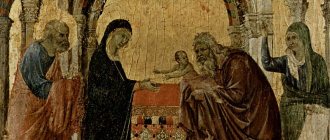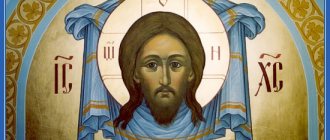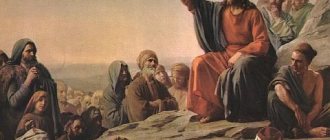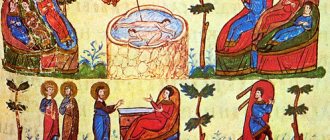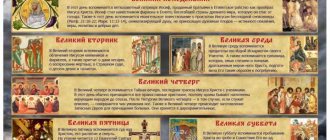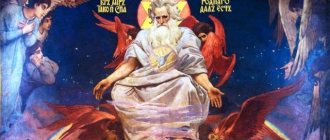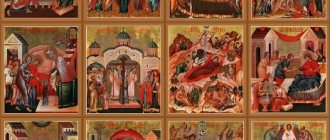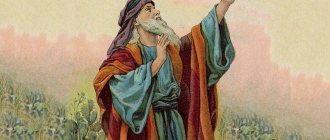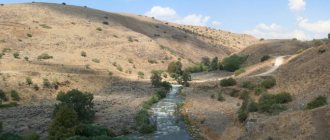| Transfiguration. 1403 (Theophanes the Greek) |
Transfiguration of the Lord
, a holiday of the Orthodox Church, belongs to the twelve. Celebrated on August 6
On this day, the appearance of Jesus Christ in divine glory (even during his earthly life) to three chosen disciples is remembered. Jesus Christ took Peter, James and John his brother, and led them up a high mountain alone. And he was transfigured before them: and his face shone like the sun, and his clothes became white as light.”
(Matt. 17:12).
“And behold, two men talked with Him, who were Moses and Elijah.
Appearing in glory, they spoke of His exodus, which he was to accomplish in Jerusalem” (Luke 9:30-31).
“And a cloud appeared overshadowing them, and out of the cloud came a voice, saying: This is my beloved Son;
Listen to Him” (Mark 9:7).
What is Transfiguration
Transfiguration (Greek metamorphosis, Latin Transfiguratio) literally translates as “transformation into another form” or “change of form.” The full name of the holiday is the Transfiguration of the Lord God and our Savior Jesus Christ. This is one of the so-called twelve holidays, which are dogmatically closely connected with the events of the earthly life of the Lord Jesus Christ and the Mother of God and are divided into the Lord's (dedicated to the Lord Jesus Christ) and the Theotokos (dedicated to the Mother of God). Transfiguration is the Lord's holiday.
The events of the Transfiguration are described in the Gospels; all the evangelists write about them, except the Apostle John. During prayer on Mount Tabor, three disciples of Jesus Christ - Peter, James and John - saw how the Teacher was transformed: After six days, Jesus took Peter, James and John his brother, and led them up a high mountain alone, and was transformed before them: and His face shone like the sun, and His clothes became white as light (Matthew 17:1-2).
In Rus', this holiday received the popular name “Apple Savior”. The fact is that in Israel and Greece the day of Transfiguration fell on the time of ripening of grapes. Christians brought fragrant bunches to the temple - for blessing and as a sign of gratitude to God. In countries where grapes do not grow, for example, in most of Russia, apples began to be blessed instead. There is a special prayer “For the consecration of the firstfruits of vegetables (fruits).”
Advantages and disadvantages
Pros:
- High yield.
- Large berries.
- Unpretentiousness.
- Self-pollinating.
- Early ripeness.
- Keeping quality.
- Good transportability.
- Attractive presentation.
- No peas.
- Fast rooting.
Minuses:
- The need for rationing.
- Deterioration of taste when overloaded.
- Average frost resistance.
- Susceptibility to fungal disease.
- Attractive to insects.
Events of the Transfiguration of the Lord
We read about the Transfiguration in three Gospels; it is not described only in the Gospel of John.
As the evangelical apostles report, the events of the Transfiguration occurred six days after Christ, in a conversation about the cross and the Kingdom of God, said: “... truly I say to you: there are some of those standing here who will not taste death until they see the Kingdom of God come in power" (Mark 9:1). The Savior took three disciples with him - Peter, James and John - and went to the mountain to pray. While Christ was praying, the disciples, tired during the day, fell asleep. But then a miracle woke them up - the Teacher “was transfigured before them: and His face shone like the sun, and His clothes became white as light” (Matthew 17:2). The prophets Moses and Elijah appeared before the Savior and spoke with Him. As the Apostle Luke writes, the conversation was “about His exodus, which He had to accomplish in Jerusalem” (Luke 9:31), that is, about the upcoming crucifixion. The Apostle Peter, amazed by the greatness of the Lord, exclaimed: “Rabbi! It’s good for us to be here; Let us make three tabernacles: one for you, one for Moses, and one for Elijah” (Mark 9:5). After these words, a light cloud appeared and covered everyone with its shadow. From the depths of the cloud the voice of God the Father was heard: This is My beloved Son, in whom I am well pleased; Listen to Him (Matthew 17:5). After this miraculous event, Christ and the disciples descended from the mountain. The Savior forbade the apostles to reveal the secret of the Transfiguration to anyone, “until the Son of Man rises from the dead” (Mark 9:9).
Divine service of the Transfiguration of the Lord
The Feast of the Transfiguration has one day of pre-celebration (August 18) and seven days of post-feast (from 20 to 26 August). The celebration of the holiday takes place in churches on August 26.
The popular name for the Transfiguration of the Lord, “Apple Savior,” reminds us of the ancient tradition of consecrating fruits on this day. In Israel and southern Christian countries, for example, Greece, the grapes were just ripe at the time of the holiday. People carried bunches of grapes, as well as ears of corn, to the temple for blessings and as a sign of gratitude to God.
On Russian lands, grapes did not grow everywhere, so the tradition was transformed - apples began to be blessed. There is a special prayer - “For the consecration of the firstfruits of vegetables (fruits).”
Comparison with analogues
Next, let’s see how “transformation” positions itself in comparison with other similar varieties.
| Sign | Variety | ||
| Transfiguration | Helios | Victor | |
| Ripening period | 100-115 days | 110-115 days | 100-110 days |
| Frost resistance | up to -23˚С | up to -24˚С | up to -24°C |
| Yield per bush | up to 20 kg | up to 10 kg | 6-7 kg |
| Bunches | up to 3 kg | up to 2 kg | up to 2 kg |
| Taste | harmonious with slight sourness | sweet with floral and fruity notes | sweet with a little sourness |
| Color | from soft pink to bright red | light red | from soft pink to purple |
| Disease resistance | average | average | high |
| Shelf life | up to 6 months | up to 3 months | up to 4 months |
Prayers of the Transfiguration of the Lord
Troparion of the Transfiguration of the Lord
Voice 7
Thou art transfigured on the mountain, O Christ God, showing Thy disciples Thy glory, as unto a man, that Thy Light, ever present through the prayers of the Mother of God, may shine upon us sinners, O Light-Giver, glory to Thee.
Translation: You were transfigured on the mountain, O Christ God, showing your disciples your glory as far as it was possible for them. May Your eternal light shine upon us, sinners, too, through the prayers of the Mother of God. Giver of light, glory to You!
Kontakion of the Transfiguration of the Lord
Voice 7
You were transfigured on the mountain, and as the host of Your disciples, they saw Your glory, O Christ God, so that when they see You crucified, they will understand the free suffering, and the world will preach that You are truly the Father’s radiance.
Translation: You were transfigured on the mountain, and as far as your disciples could comprehend, they contemplated your glory, O Christ God, so that when they saw you crucified, they would understand that your suffering was voluntary and proclaim to the world that you are truly the Father’s radiance.
The Greatness of the Transfiguration of the Lord
We magnify You, Life-Giving Christ, and honor Your most pure flesh, the glorious Transfiguration.
Translation: We magnify You, Giver of life Christ, and honor Your most pure flesh with your glorious transfiguration.
“Apple Savior” - folk traditions of the Transfiguration holiday
The Feast of the Transfiguration of the Lord in Rus' was also called Apple Savior, Savior, Second Savior, Feast of First Fruits, Savior on the Mountain, Middle Savior, Pea Day, Second Meeting of Autumn, First Autumn, Autumn.
“First autumn” means welcoming autumn. Summer was waning, peasants were harvesting crops in the fields and gardens. Apples were brought to churches for blessing. Above them the priest read a special prayer - “For the consecration of the firstfruits of vegetables (fruits).” From this moment on, believers could begin to eat apples and other fruits of the new harvest.
On Apple Spas, housewives baked apple pies and made jam. Relatives and friends were invited to the treat. There was a tradition of feeding the poor - for the glory of God. If someone refused to do this good deed, he was reproached in every possible way: “God forbid, God forbid, to have anything to do with them! He forgot the old and the orphan, did not give them any small good from his wealth, did not look upon the sick and the poor with his goods!” Even on Transfiguration, they sang songs and saw off the sun in the field.
Beneficial features
Grapes are very healthy due to the content of large amounts of vitamins, minerals, glucose, organic acids, proteins, pectins and flavonoids. That is why it is often used for the prevention and treatment of cardiovascular, kidney and pulmonary diseases. In addition, berries are excellent stress relievers and help fight depression.
Also, the fruits of the culture have a restorative, invigorating, antibacterial, anti-cold effect, reduce the risk of cancer, improve memory and normalize the functioning of the digestive system.
| Benefits of grapes | ||
| for men | for women | for children |
| helps fight infertility; | maintains youthful and elastic skin; | strengthens the immune system; |
| supports normal sexual function; | normalizes hormonal levels; | serves as a source of calcium necessary for the formation of the skeleton; |
| improves the quality of seminal fluid. | improves mood; | prevents the occurrence of anemia; |
| helps fight pain during menstruation. | improves appetite. | |
Metropolitan Anthony of Sourozh. Sermon on the Feast of the Transfiguration
The Feast of the Transfiguration reveals to us the glory of God's created creation. Not only did Christ appear in the glory of the Father, in His Divine glory on this day before His disciples: the Gospel tells us that Divine light streamed from His physical body and from the clothes that covered it, poured out onto everything that surrounded Christ.
Here we see something that was already secretly revealed to us in the Incarnation of Christ. We cannot think about the Incarnation without bewilderment: how was it possible that human flesh, the matter of this world, collected in the body of Christ, could not only be the place of indwelling of the Living God - as happens, for example, in a temple - but be united with the Divinity in such a way that is this body permeated with Divinity and now sits at the right hand of God the Father in eternal glory? Here all the greatness, all the significance of not only man, but the material world itself and its indescribable possibilities are revealed to us in secret - not only earthly and temporary, but also eternal, Divine.
And on the day of the Transfiguration of the Lord, we see with what light this material world of ours is called to shine, with what glory it is called to shine in the Kingdom of God, in the eternity of the Lord... And if we carefully and seriously take what is revealed to us here, we must change in the most profound way our attitude to everything visible, to everything tangible; not only to humanity, not only to man, but to his very body; and not only to the human body, but to everything that is physically around us, perceptible, tangible, visible... Everything is called to become a place of infusion of the grace of the Lord; everything is called once, at the end of time, to be absorbed into this glory and to shine with this glory.
And it is given to us, people, to know this; it has been given to us, people, not only to know this, but also to be co-workers with God in the sanctification of the creation that the Lord created... We consecrate fruits, consecrate waters, consecrate bread, we consecrate bread and wine into the Body and Blood of the Lord; within the boundaries of the Church this is the beginning of the miracle of Transfiguration and Epiphany; human faith separates the substance of this world, which is betrayed by human unbelief and betrayal to decay, death and destruction. By our faith it is separated from this corruption and death, given into the ownership of God, and accepted by God, and in God now, in embryo, truly becomes a new creation.
But this should extend far beyond the boundaries of the temple: everything without a trace that is subject to man can be sanctified by him; everything we work on, everything we touch, all the objects of life - everything can become part of the Kingdom of God, if this Kingdom of God is within us and, like the radiance of Christ, spreads to everything we touch...
Let's think about it; we are not called to enslave nature, we are called to free it from the captivity of corruption and death and sin, to free it and return it to harmony with the Kingdom of God. And therefore, let us begin to thoughtfully and reverently treat all this created world that we see, and let us serve as co-workers with Christ in it, so that the world may achieve its glory and so that all created things may enter into the joy of the Lord. Amen.
(August 19, 1973)
Transfiguration of the Lord in Armenia
The Transfiguration of the Lord is called “Vardavar” in Armenian. In the Armenian Apostolic Church, this holiday is celebrated on the 98th day after Easter, that is, in the period from June 28 to August 1.
On Transfiguration, doves are released into the sky, and Armenians also have an ancient tradition of pouring water on each other. This is a cheerful and kind custom that no one is offended by, because pouring water on this day means giving a gift. Anyone, even a random passerby, can be doused with water. Everyone from young to old takes part in the celebration, children are especially happy.
Origin
“Transfiguration” is the brainchild of a talented amateur breeder from Novocherkassk V.N. Krainov. The winegrower is known for its high-yielding hybrids - the Victor and Jubilee Novocherkassk varieties, which together with the hero of the article form the so-called “Kraynov Troika”.
Parents of “transfiguration” – “radiant sultana” and “talisman”
The “Transformation” variety is the result of crossing “Kishmish radiata” and “Talisman”. He absorbed the best qualities of his “parents”:
- Good yield.
- Early ripeness.
- Excellent taste.
The variety was included in the State Register of the Russian Federation in 2014, although it gained its popularity even before official recognition.
Preobrazhenskoye Cemetery
Preobrazhenskoye Cemetery is located in Moscow, Preobrazhensky Val, 17a. This is a former Old Believer cemetery. It was founded during an epidemic.
In 1764, the monastery was abolished and the church became a parish. In those years, a multi-tiered bell tower was added to it. Over time, the first stone building of the temple came under threat: the soil on the river bank gradually subsided. In 1886, a new church was built and consecrated in honor of the Transfiguration of the Lord.
After the revolution, Tushino became a major industrial center. Factories and an airfield were built in the village. The temple was closed in
During the Soviet years, the temple building was used as a club. In 1956, local residents asked to return the shrine to the Church, but they were refused. Only in 1990 did the church begin to revive parish life again. In 1994, a bell tower was added to the temple.
Poems about the Transfiguration
Boris Pasternak. August
As promised, without deceiving, the sun penetrated early in the morning with a slanting strip of saffron From the curtain to the sofa.
It covered the neighboring forest, the houses of the village, my bed, my wet pillow and the edge of the wall behind the bookshelf with hot ocher.
I remembered why the pillow was slightly moistened. I dreamed that you were walking through the forest one after another to see me off.
You were walking in a crowd, separately and in pairs, Suddenly someone remembered that today is the sixth of August in the old days, the Transfiguration of the Lord.
Usually light without flame comes from Tabor on this day, and autumn, clear as a sign, attracts the eyes to itself.
And you walked through the small, beggarly, naked, trembling alder forest, into the ginger-red cemetery forest, burning like a printed gingerbread.
With its hushed peaks
The nearby sky was important, And the distance echoed with the voices of roosters.
In the forest, as a government surveyor, Death stood in the middle of the graveyard, Looking into my dead face, To dig a hole according to my height.
The calm voice of someone nearby was physically felt by everyone. Then my visionary voice sounded untouched by decay:
“Farewell, the azure of Preobrazhenskaya and the gold of the second Savior, soften the bitterness of the fateful hour with the last feminine caress for me.
Goodbye years of timelessness. Say goodbye to the abyss of humiliation. Challenging woman! I am your battlefield.
Farewell, the spread of the wingspan, the free perseverance of flight, and the image of the world revealed in the word, and creativity and miracle-working.”
Features of planting grapes
The survival rate of the hybrid form of the transformation is good, the seedling quickly adapts in place, but for rooting, intensive growth and development, the plant must be properly prepared and planted.
When to plant?
The time for planting is chosen taking into account the climate of your region. You can plant grafted and own-rooted Transfiguration grape seedlings in spring and autumn. This is most often done in the spring, when the soil warms up to 7-8ºС.
Planting cuttings of a one-year-old fruit-bearing vine is carried out later, at a soil temperature of 10-12ºС, and air temperature not lower than +15ºС. It is better not to plant such planting material in the fall.
Selecting a location and preparing a planting hole
The taste of the grapes and the richness of their color largely depend on the level of illumination of the area. Sweet berries with an intense blush are obtained when the plant does not lack light. Therefore, it is important to choose a location away from large trees and shrubs.
The place should be calm, sunny, on the south side of the site, ideally protected from the wind by a building wall or fence. The groundwater level is at least 1.5 m from the soil surface.
For spring planting of seedlings, the hole is prepared in the fall:
- Dig a hole measuring 60x60 cm, the depth is the same.
- Place the top layer of soil close to the hole.
- Place the less fertile lower layer of soil on the other side.
- Place 1 bucket of compost or rotted manure at the bottom of the hole (you can mix organic matter 1:1).
- Apply potash and phosphate fertilizers (100 g each).
- Fill with half the soil taken from the top layer.
- Stir, add another bucket of organic matter and the same dose of fertilizer.
- Rake the second part of the fertile soil into the hole and mix.
- Fill the hole to the top with soil from the bottom layer.
With this method of distribution of nutrients, the roots will not be able to find nutrition in the upper layers and will begin to grow deeper. This arrangement of the root system will help the grapes withstand both drought and winter cold.
Preparation of seedlings
The best survival rate of grapes planted in spring. Purchase seedlings in advance or prepare cuttings yourself. The root system of a healthy seedling is whitish in color, and the cut of the stem is green. Check the integrity of the bark; there should be no damage.
If the plant has produced new sprouts from the buds, they are removed, leaving one of the largest ones. Remove dried branches and leaves, if any. The top of the main sprout is cut off, leaving a part of the stem with five eyes.
The tips of the roots are trimmed so that their total length does not exceed 15-17 cm. Next, the roots of the plant are soaked in water at room temperature, to which one of the stimulants is added, for example, Kornevin or Humate. All this is done 1-2 days before planting.
Step-by-step instructions for landing
In mid-spring, when the earth has warmed up, they begin planting grapes. It consists of the following steps:
- make a hole with a mound in the middle in the hole prepared in the fall;
- lower the seedling onto the mound and spread the roots of the plant evenly;
- cover with soil, compacting it well;
- pour plenty of water;
- mulch the tree trunk circle.
